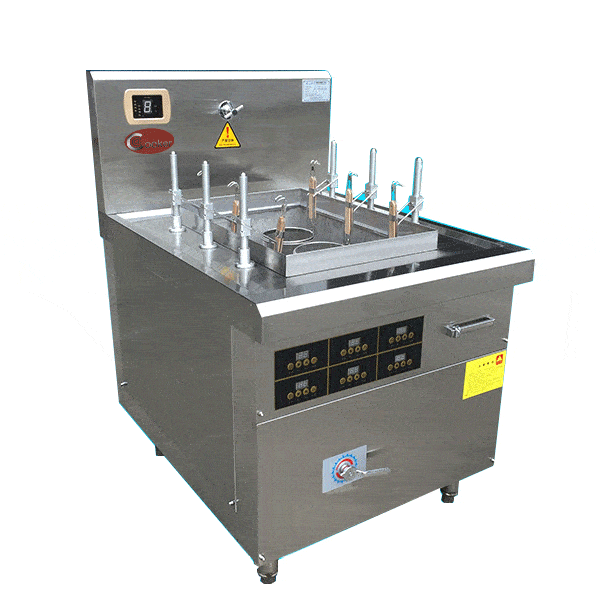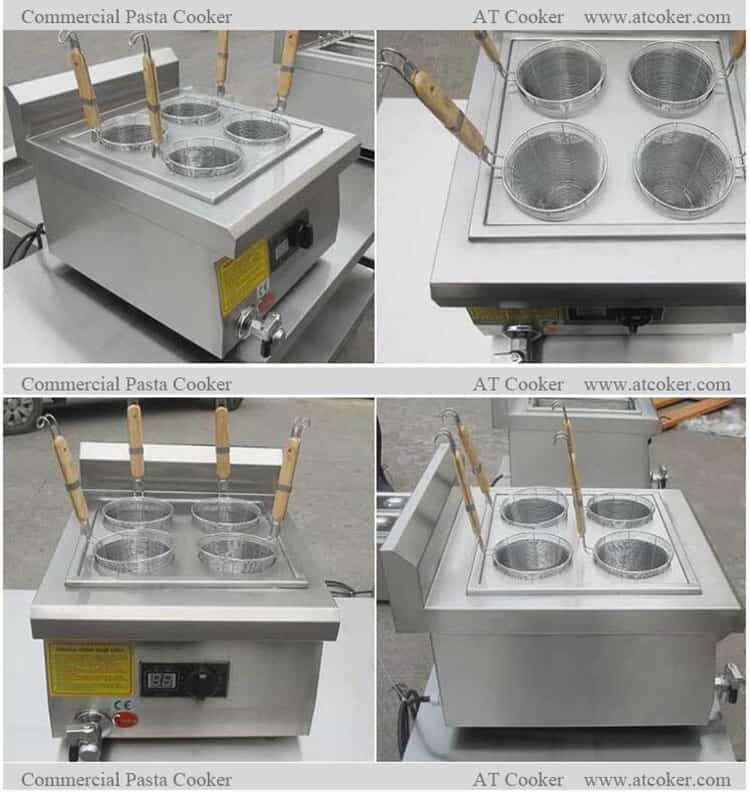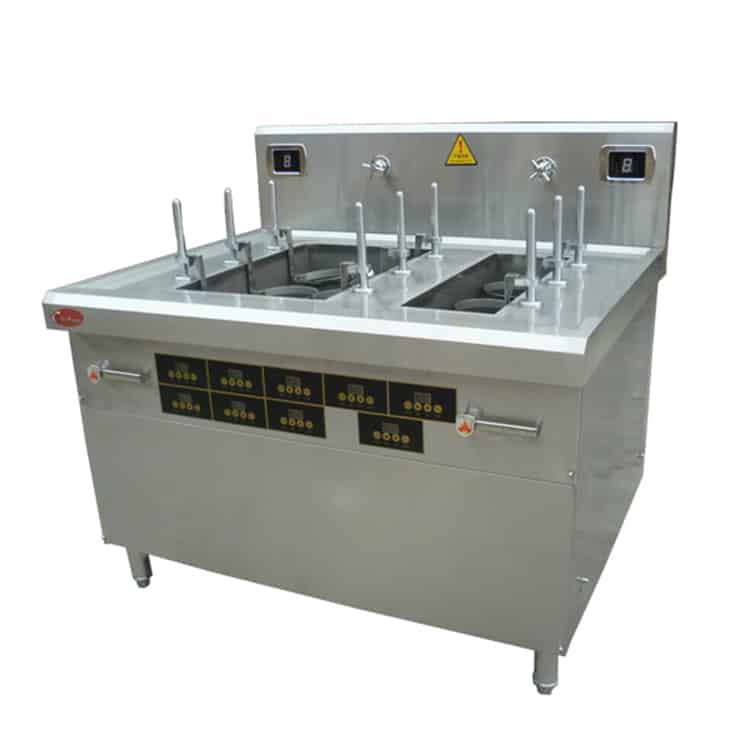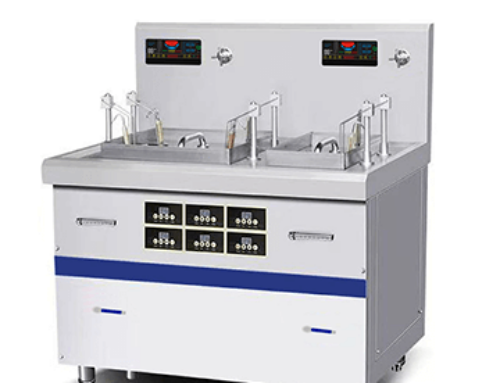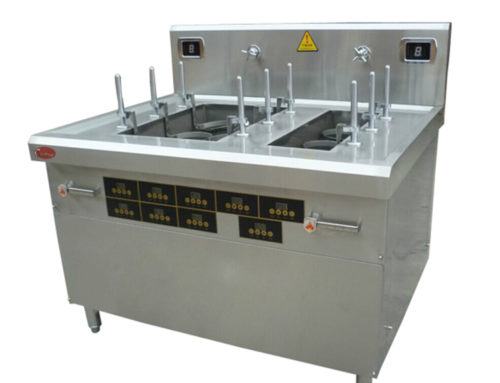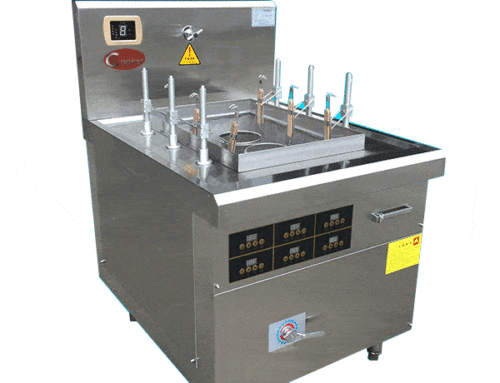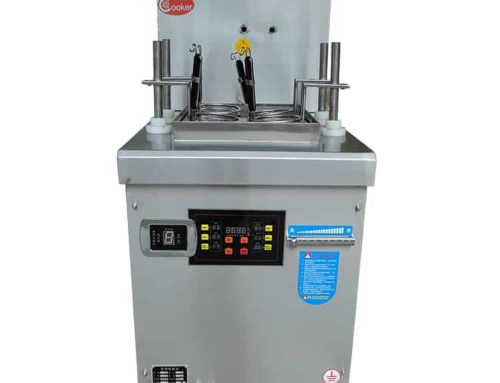How Does the Capacity of the Pasta Cooker Affect Its Suitability for Various Kitchen Sizes and Demands?
A pasta station’s capacity—measured by water tank volume (23L to 60L+) and batch cooking output—directly determines its fit for commercial kitchens, from tiny food trucks to large banquet halls. The right capacity balances efficiency (batch speed, labor needs) and practicality (space, energy use), while the wrong size leads to bottlenecks or wasted resources.
AT Cooker’s commercial pasta cooker lineup (e.g., 23L tabletop models to 60L industrial boilers) is engineered to match diverse demands. Below, we break down how capacity impacts suitability, using real product examples and data to guide kitchen operators in choosing the right electric pasta cooker or commercial pasta equipment.
1. Large-Capacity Pasta Cookers for High-Volume Restaurants & Banquets
Large-capacity pasta cookers (40L–60L water tank, 15KW–20KW power) excel in high-demand settings like busy Italian restaurants, hotels, and banquet halls—where 50+ portions of pasta are needed per hour. These units, such as AT Cooker’s ATT-APSD-A6 pasta boiler machine (15KW, 45L capacity), can cook 12–15 pounds of pasta per batch—enough to serve 40–60 customers at once.
A hotel in Las Vegas uses two ATT-APSD-A6 units for wedding banquets: “We serve 200+ guests, and each cooker handles 6 batches per hour. Before, we used three small cookers and still fell behind—now we cut cooking time by 40%.”
2. Small-Capacity Models for Food Trucks & Cafés
Small-capacity pasta cookers (20L–25L water tank, 5KW power) are designed for compact spaces like food trucks, kiosks, and small cafés—where counter space is scarce (2–3 square feet) and daily output is 20–30 portions. AT Cooker’s ATT-APST-C5B table top pasta cooker (5KW, 23L capacity) fits on standard countertops (480×570×400mm) and cooks 3–4 pounds of pasta per batch.
A food truck operator in Austin relies on the ATT-APST-C5B: “My truck’s kitchen is only 4 feet wide—this cooker fits next to my fryer, and I can still move around. It cooks 10 portions of fettuccine at once, which matches my lunch rush volume.”
- Weight: 35–45 lbs (easy to install/relocate)
- Water refill frequency: Every 2–3 batches (low maintenance for small teams)
- Best for: Kitchens with peak demand < 30 portions/hour
| Model (AT Cooker) | Capacity (Water Tank) | Batch Output | Power | Max Portions/Hour | Ideal Kitchen Type |
|---|---|---|---|---|---|
| ATT-APST-C5B (Table Top) | 23L | 3–4 lbs (12–16 portions) | 5KW | 30–40 | Food trucks, cafés |
| ATT-APSD-A4 (Automatic) | 35L | 8–9 lbs (32–36 portions) | 10KW | 60–70 | Mid-sized restaurants |
| ATT-APSD-A6 (Boiler) | 45L | 12–15 lbs (40–60 portions) | 15KW | 90–120 | Banquets, high-volume spots |
| ATT-APSD-A9 (Industrial) | 60L | 18–20 lbs (72–80 portions) | 20KW | 120–150 | Hotels, catering halls |
3. Capacity Impacts Energy & Water Costs
Large-capacity pasta cooker commercial models use more resources, but their cost per portion is lower. For 10 batches daily ($0.15/kWh):
- Small cooker (23L): 0.5 kWh/batch → $0.75/day → $0.025/portion
- Large cooker (45L): 1.5 kWh/batch → $2.25/day → $0.015/portion
Water use follows the same pattern: large cookers need 45L/batch, small ones 23L. A restaurant using 10 batches daily saves 220L of water (80,300L annually) with a small unit—but large cookers shine for high demand.
— Lisa, Catering Company Owner (Miami, FL)
Small Cooker (23L)
Energy Cost (10 batches)
$0.025/portion
Medium Cooker (35L)
Energy Cost (10 batches)
$0.020/portion
Large Cooker (45L)
Energy Cost (10 batches)
$0.015/portion
4. Capacity & Installation Space
Capacity directly impacts footprint—large cookers need 4–6 square feet (e.g., ATT-APSD-A6: 800×800×1200mm), while small tabletop models fit in 1–2 square feet (ATT-APST-C5B: 480×570×400mm). This makes large units unsuitable for tight spaces like food trucks.
A restaurant in Chicago made a costly mistake: “We bought a large cooker without measuring—our kitchen only had 3 square feet of free space. We had to rebuild the counter, adding $1,800 to our budget.”
Capacity & Menu Flexibility
- Small (23L): 2–3 baskets → 2–3 pasta types/hour (ideal for simple menus like “spaghetti only”).
- Medium (35L): 3–4 baskets → 4–5 pasta types/hour (great for mid-sized menus with penne, fettuccine, and ravioli).
- Large (45L+): 4–6 baskets → 6–8 pasta types/hour (perfect for buffets or fusion restaurants with diverse options).
5. Safety & Maintenance for Large-Capacity Models
Large-capacity cookers need advanced safety features to mitigate risks (e.g., water overflow, overheating). AT Cooker’s large models include:
- Overflow sensors: Auto-stop water fill when the tank is full (prevents slips).
- Overheat protection: Shuts off the heating element if temperature exceeds 220°F (avoids damage).
- GFCI outlets: Prevent electric shock (critical for wet kitchen environments).
Maintenance also scales with size: a 45L tank takes 20 minutes to clean (vs. 10 minutes for 23L) but includes features like faucet drains to simplify the process.
Find the Right-Capacity Pasta Cooker for Your Kitchen
Share your daily portion demand and kitchen space—we’ll recommend a commercial pasta cooker that balances efficiency and practicality.
